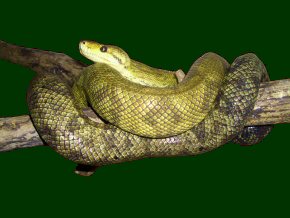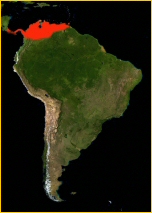

Description
 Corallus ruschenbergerii is the largest of the four species that previously been assigned to Corallus hortulanus. This is a recently described species designated in 1997 in a systemic review of the amazon tree boa complex (Henderson 1997). This is easily the most divergent species of the complex, both in morphology and in analysis of its mtDNA.
Corallus ruschenbergerii is the largest of the four species that previously been assigned to Corallus hortulanus. This is a recently described species designated in 1997 in a systemic review of the amazon tree boa complex (Henderson 1997). This is easily the most divergent species of the complex, both in morphology and in analysis of its mtDNA.
This is the largest species of the group, growing to lengths of nearly 7ft. In addition to its length, this tree boa is more robust in its build than its relatives. Large adult Central American tree boas can even rival emerald tree boas in terms of size. When compared to other members of the Amazon tree boa complex, this form has much larger  scales.
scales.
Corallus ruschenbergerii throughout most of its distribution lacks the variability of color and pattern seen in the other tree boas. This species is typically clad in more subdued tones. Most specimens have an olive colored base and are patterned with a series of dark rhomboids. The overall coloration darkens toward the tail giving this species one of its common names the 'black tailed tree boa'. Specimens from the southern portion of their range can be the most colorful, with red and yellow specimens known from Venezuela. There also exists a patternless form known from Trinidad and Tobago.
Habitat
_thm.jpg) This strongly arboreal species inhabits lowland dry forest, thorn forest, savanna grassland with woody species (llanos with gallery forests), and lower montane dry forest. On Trinidad and Tobago and in Central America it occurs in tropical moist forest. Central American tree boas can also be found in coastal mangroves.
This strongly arboreal species inhabits lowland dry forest, thorn forest, savanna grassland with woody species (llanos with gallery forests), and lower montane dry forest. On Trinidad and Tobago and in Central America it occurs in tropical moist forest. Central American tree boas can also be found in coastal mangroves.
Distribution
 This species ranges from south western Costa Rica southward into northern Columbia and northern Venezuela. A population also exists on the islands of Trinidad and Tobago.
This species ranges from south western Costa Rica southward into northern Columbia and northern Venezuela. A population also exists on the islands of Trinidad and Tobago.
Projects
I am currently working with 1.1 c.b. specimens from Costa Rica as well as a single adult male from Trinidad.
